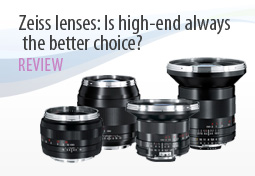This quality is reflected in our metrics. The Zeiss family usually has very good light transmission and little distortion. The chromatic aberration may sometimes look important at first sight, but analyzing it a bit more carefully shows that yes, it may be big, but it is confined to the outermost edge of the corners of the image, leaving the rest of the field absolutely perfect. This means that even if a Zeiss lens has a bigger LCA metric in our global view, it might indeed be much better than any other competitor on 99% of its field.
Impressive? Yes, indeed. And in this respect, Zeiss lenses really show high-end performance.
On the other hand, these lenses also show some weaknesses – the most obvious being the lenses’ measured sharpness. Oh, most of them are sharp, and sometimes very sharp. But all too often they are not the sharpest lenses, and it can happen sometimes that a $1300 Zeiss lens can be outperformed by a $400 lens from Canon or Nikon. This is not so rare a case, and a user looking mostly for higher resolution could be a bit disappointed. Take the 85mm range, for instance; the $380 Canon 85mm f/1.8 USM is almost 10 lp/mm sharper than the $1300 Planar T85mm f/1.4ZE on the same full-frame 5D MkII sensor. That’s quite a big difference, especially when the cheaper lens also has less distortion, LCA, and vignetting.
So although these lenses are masterpieces of build quality, their results may not always be as good as expected. (This case is not specific to Zeiss. In our recent study of 50mm lenses, we pointed out that the best 50mm for a Canon mount was not an L series, and that the Nikkor’s $100 “full plastic” 50mm f1.8D was a terrific performer as well.)
Moreover, in 2011, we may reasonably question the pertinence of sticking to the “manual focus only” philosophy. That’s obviously a daring choice, making Zeiss lenses ideal for some “manual purists”; but all other users should know prior to buying a manual lens that perfect manual focusing is extremely hard, and takes time. Today’s high-resolution sensors require perfect focus; the slightest blur becomes obvious when the image is viewed at 100%.
Today’s AF engines are efficient, fast and silent, as they help photographers produce high-quality pictures. And for those preferring to focus manually, all modern AF lenses offer a permanent manual override, thus efficiently marrying the best of two worlds. Comfort is not evil… is it? A lens with good AF is not necessarily of lower quality than a full manual lens. There is already an army of good reasons that may potentially cause someone to miss a shot. Adding the lack of both AF and stabilization, especially on long focal ranges, does not really help. In 2011, autofocus should no longer be taboo.



DXOMARK encourages its readers to share comments on the articles. To read or post comments, Disqus cookies are required. Change your Cookies Preferences and read more about our Comment Policy.